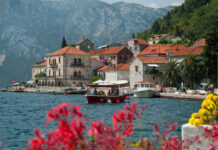Britain’s historic pilgrims’ routes are alive and well and attracting increasing numbers of walkers. A travel expert says many new people are discovering the age-old attractions of the UK’s pilgrim trails to Canterbury and Holywell.
While pilgrimages may sound as much a part of history as the Black Death and witchcraft trials they are, in fact, booming in popularity. For example, the Camino de Santiago de Compostela – Europe’s most popular pilgrimage to the shrine of the Apostle James in Northwest Spain – was completed by a record 442,073 people last year.
For Brits who can’t spare the (many) days needed to complete a full European pilgrimage, in the UK several ancient pilgrim trails to historic spiritual sites are also flourishing. From Canterbury to Holywell, there are a number of pilgrimage sites that date back centuries and appeal to walkers and those seeking a spiritual adventure.
Lily Smith, a leading travel expert from Monasteries.com, says: ‘Britain’s remarkable pilgrim trails offer a very different kind of holiday for people wanting to better understand their country, keep fit or to recharge their spiritual batteries. Even this summer, when the sun seems to have forgotten how to shine, many people have already completed an historic pilgrim trail. To paraphrase John Bunyan’s The Pilgrim’s Progress: “There’s no discouragement, shall make them once relent, their first avowed intent, to be a pilgrim.”
‘Canterbury Cathedral, where Archbishop Thomas Becket was martyred in 1170, was already an old pilgrimage route by the time Geoffrey Chaucer wrote The Canterbury Tales in around 1400. His colourful band of pilgrims set out from the Tabard Inn in Southwark, London. Sadly, this was demolished in the Victorian era but the nearby George Inn, the only surviving galleried coaching inn in London, gives a flavour of what it may once have been like.
‘To really enter the spirit of a pilgrimage it’s even possible to stay in some monasteries and other places owned by religious institutions along the routes. For example, St. Monica House in Kennington, London, is run by the Maltese Province of the Augustinian Sisters Servants of Jesus and Mary, who live in the convent next door. It is a bright, clean and friendly place where people can rest while enjoying the beautiful sites of London and there is availability from September from just £74.75 a night.
‘Of course, Chaucer’s route has a little more traffic now than it did in the medieval period. That’s why many people follow the equally old Pilgrims’ Way to Canterbury from the historic cathedral city of Winchester.
‘Many walkers actually choose to start their walk in Winchester’s sister cathedral city, Salisbury. The Clarendon Way links these two ancient cities. Modern pilgrims can stay at Sarum College, a theological college based in 17th-century buildings just opposite Salisbury Cathedral, within its 80-acre Close. Rooms are available in July and beyond from just £65 a night.
‘From Winchester, the Pilgrims’ Way “proper” is a 119-mile (192km) walk following an ancient trackway actually dating back to pre-Christian times, possibly as long ago as 600BC. It runs the entire length of the North Downs, linking the English Channel to the ancient religious sites of Avebury and Stonehenge. To avoid traffic, we recommend people walk the St Swithun’s Way between Winchester and Farnham and then the North Downs Way National Trail from Farnham to Canterbury.
‘Canterbury is far from being the only UK pilgrimage destination. One of Monasteries.com’s favourite routes is Holywell to Bardsey Island, North Wales. This 130-mile (215km) Pilgrim’s Way begins in Holywell, Flintshire.
‘As its name implies, for centuries Holywell was important for its Holy Well. Visitors can still explore the ancient St Winefride’s well shrine. Here, too, it’s possible to stay in a religious community. The Bridgettine Sisters welcome visitors to St Winefride’s Guest House, where the neighbouring Convent Chapel is always open to pilgrims and visitors. Rooms are available this summer from £74 a night.
‘From the atmospheric ruins of Holywell’s Basingwerk Abbey, the route heads west. At Abergwyngregyn the path borrows sections of the Wales Coast Path and Llyn Coast Path, a designated Area of Outstanding Natural Beauty, and visits many stone churches dedicated to Celtic saints. Bardsey Island has been an important religious site since the 6th century and is known as the “island of 20,000 saints”. The island is now well-known for its scenery, wildlife and rugged coastline.
‘Booking a stay in an abbey or monastery on the route of these UK pilgrimages is surprisingly easy. The unique accommodation site Monasteries.com provides a booking platform for religious orders with stays across mainland Europe, Great Britain and Ireland. He (or she) who would valiant be, will find much more information about UK pilgrimage trails and how to book at https://www.monasteries.com/







